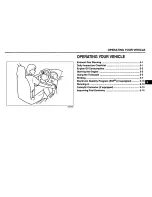
Traqmate User Manual V1.0
June 14, 2005
Copyright © 2005 Track Systems Technologies, LLC
Page 29
Friction Circle
The Friction Circle graph shows the forces acting on
the vehicle in the forward, reverse, left, and right
sides, plotted on an X,Y Graph where the vertical
axis is Braking/Acceleration and the horizontal axis
is Left/Right Loading. For most vehicles, the shape
of the Friction Circle graph will be an inverted
triangle. The reason for this is that most vehicle stop
much better than they accelerate so more forces will
be generated in that direction.
This graph is used to gauge the overall amount of
performance available in the car and the amount of
that capability the driver is using. Especially of
interest are the transitions from braking to turning to
acceleration. By watching the cursor move around
the graph during playback, you can see the transitions. It is useful to picture the car from
overhead as in the diagram and think of the cursor as the top of the driver’s helmet.
Braking
Right Loading
Left Turns
Left Loading
Right Turns
Acceleration
Cursor Moves
With Vehicle
Motion
Peak
Values
Sustained
Levels
Unused
Grip
Figure 26 - Friction Circle Graph
Note that the Friction Circle shows peak loads. A tire near maximum grip level is constantly
gripping and releasing the pavement. In addition, a hard turn-in will generate instantaneous loads
that are not sustainable. The extremely sensitive accelerometers will pick this up, creating peaks
in the data. While these are real, the actual sustained level of grip that can be measured on a
skidpad is somewhat lower.
Braking
Right Loading
Left Turns
Left Loading
Right Turns
Acceleration
















































